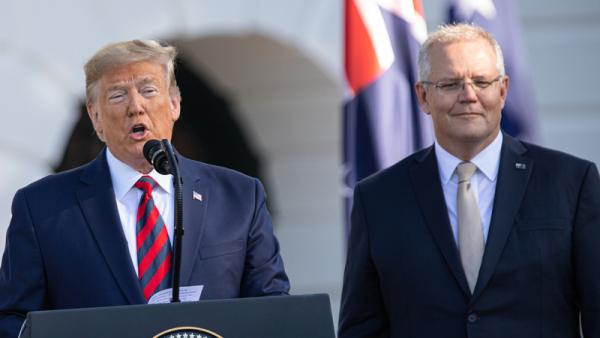aschwaphoto / Shutterstock

James Laurenceson, Acting Director, Australia-China Relations Institute, University of Technology Sydney |
This article appeared in The Australian Financial Review on September 25 2019.
Scan the headlines generated by Scott Morrison’s trip to the United States and you could get the impression that the Australian government is increasingly tilting towards supporting Washington in its economic war against Beijing.
Yesterday the Prime Minister attracted attention for telling an audience in Chicago that he no longer regarded China as a 'developing country'. Rather, it was a 'newly developed economy'.
Such assessments would have pleased his hosts. The Trump administration has made much of China being able to declare itself a 'developing country' under World Trade Organisation rules, potentially entitling it to so-called 'special and differential treatment'.
Rather than aggregate economic size, the Chinese government prefers to draw attention to per capita incomes in China still not having reached one-third of those in the US.
In reality, a good deal of the bluster around China’s developing country status is overblown. For example, it is countries such as the US, not self-declared 'developing countries', that get to choose which WTO members can benefit from any preferences they decide to offer.
China’s status also has no bearing on needing to fully meet the commitments made in the accession agreement it struck with other WTO members, including the US, in 2001.
During his visit Morrison has also spoken in support of other US grievances against China, including those relating to theft of intellectual property.
But here’s the truth bomb for Washington and excited sections of the local commentariat: despite all the pomp and pageantry of a state visit, none of what Morrison has said these past few days goes beyond what he told an audience in Sydney back in June.
Delivering an address at Bloomberg, Morrison called out the fact that China’s most successful provinces had reached the economic sophistication of their global competitors and yet could compete on terms that were 'not available to other developed countries'.
And aside from intellectual property, he added that other US concerns about China, such as those relating to forced technology transfer and industrial subsidies, were also legitimate.
Yet far from reacting angrily, China’s foreign ministry said it 'appreciated' that Morrison’s speech had on the whole welcomed China’s economic growth, as well as his ongoing commitment to deepening the Australia-China comprehensive strategic partnership.
Morrison hasn’t gone weak-kneed in the US: rather, he doubled down on that position in Chicago, and in the White House before that.
In remarks that were less widely reported, Morrison made plain to his American interlocutors that Australia wouldn’t be viewing China through a Washington lens. Instead, he stated plainly that 'the first thing to do is acknowledge that Australia and the US come at this from a different perspective'.
And as in June, China should be heartened by what Morrison told his American listeners next: 'From Australia’s point of view, the engagement with China has been enormously beneficial … that’s what led us to a comprehensive strategic partnership … and we want to see that continue.'
Morrison’s consistent position stems from a clear-eyed view of Australia’s national interest, where one in five local jobs rely on trade. At a doorstop in Washington a few days ago, he declared that ties with China had been an 'absolute boon' for Australia.
Of first-order importance is an international economic system based on rules that all countries can live with, and Australia will work hard with both the US and China to achieve this end.
The big economic policy question, and one that has not been settled by this trip, is whether the US remains a reliable partner for Australia in this context.
After all, if the US were really serious about bolstering trade rules, it would not have abandoned the Trans-Pacific Partnership, which filled many of the WTO’s gaps.
And it would have worked with willing partners such as Australia to offer up serious proposals to improve the WTO’s independent dispute resolution body. Instead, the US is blocking the appointment of new judges unless it gets its way, an approach that will cause the body to cease functioning in a couple of months.
Meanwhile, last month Trade Minister Simon Birmingham was in Beijing, where he announced that the Morrison government was looking for partners to work to improve the WTO's 'functionality and responsiveness'.
The great foreign policy achievement of the Morrison government to date is that it has refused to allow Australia’s complex relationship with China to be cast in simple, adversarial terms.
Beijing often hasn’t helped, such as by deciding earlier this month to pursue vague espionage charges against an Australian, Yang Hengjun, while denying him basic standards of justice such as the right to see a lawyer and his family.
If it were smart, China would move quickly to extend an invitation for Morrison to visit and kick-start progress in the relationship. As the Prime Minister showed in the US this week, despite the differences that Australia and China have, there’s plenty of common ground and Canberra remains open to the possibilities that greater co-operation can bring.
Author
Professor James Laurenceson is Acting Director of the Australia-China Relations Institute at the University of Technology Sydney.


